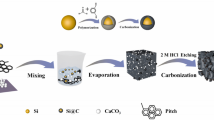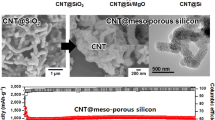Abstract
Herein, a new polythiophene-coated silicon composite anode material was prepared by in situ chemical oxidation polymerization method. The structure of this material was characterized by infrared spectroscopy, which proved that the oxidative polymerization of thiophene occurred mainly in α position. The polythiophene can provide the better electric contact between silicon particles. Therefore, the as-prepared Si/polythiophene composite electrodes achieve better cycling performance than the bare Si anode. The specific capacity of the composite electrode retains 478 mA h g−1 after 50 cycles.










Similar content being viewed by others
References
Gao P, Yang J (2011) Si-based composite anode materials for Li-ion batteries. Progress in Chemistry 23(0203):264–274
Bruce PG, Scrosati B, Tarascon JM (2008) Nanomaterials for rechargeable lithium batteries. Angew Chem Int Ed 47(16):2930–2946
Wu H, Cui Y (2012) Designing nanostructured Si anodes for high energy lithium ion batteries. Nano Today 7(5):414–429
Ryu JH, Kim JW, Sung Y-E, Oh SM (2004) Failure modes of silicon powder negative electrode in lithium secondary batteries. Electrochem Solid-State Lett 7(10):A306–A309
Szczech JR, Jin S (2011) Nanostructured silicon for high capacity lithium battery anodes. Energy & Environmental Science 4(1):56–72
Xu Y, Yin G, Ma Y, Zuo P, Cheng X (2010) Nanosized core/shell silicon@carbon anode material for lithium ion batteries with polyvinylidene fluoride as carbon source. J Mater Chem 20(16):3216–3220
Wang B, Li X, Qiu T, Luo B, Ning J, Li J, Zhang X, Liang M, Zhi L (2013) High volumetric capacity silicon-based lithium battery anodes by nanoscale system engineering. Nano Lett 13(11):5578–5584
Wu H, Chan G, Choi JW, Ryu I, Yao Y, McDowell MT, Lee SW, Jackson A, Yang Y, Hu L, Cui Y (2012) Stable cycling of double-walled silicon nanotube battery anodes through solid-electrolyte interphase control. Nat Nanotechnol 7(5):310–315
Xia F, Kim SB, Cheng H, Lee JM, Song T, Huang Y, Rogers JA, Paik U, Park WI (2013) Facile synthesis of free-standing silicon membranes with three-dimensional nanoarchitecture for anodes of lithium ion batteries. Nano Lett 13(7):3340–3346
Li H, Zhou H (2012) Enhancing the performances of Li-ion batteries by carbon-coating: present and future. Chem Commun 48(9):1201–1217
Guo S, Li H, Bai H, Tao Z, Chen J (2014) Ti/Si/Ti sandwich-like thin film as the anode of lithium-ion batteries. J Power Sources 248:1141–1148
Nishide H, Oyaizu K (2008) Toward flexible batteries. Science (New York, NY) 319(5864):737–738
Rogers JA, Someya T, Huang Y (2010) Materials and mechanics for stretchable electronics. Science (New York, NY) 327(5973):1603–1607
Naoi K, Morita M (2008) Advanced polymers as active materials and electrolytes for electrochemical capacitors and hybrid capacitor systems. The Electrochemical Society Interface 17(1):44–48
Snook GA, Kao P, Best AS (2011) Conducting-polymer-based supercapacitor devices and electrodes. J Power Sources 196(1):1–12
Laforgue A, Robitaille L (2010) Deposition of ultrathin coatings of polypyrrole and poly(3,4-ethylenedioxythiophene) onto electrospun nanofibers using a vapor-phase polymerization method. Chem Mater 22(8):2474–2480
Nyström G, Razaq A, Strømme M, Nyholm L, Mihranyan A (2009) Ultrafast all-polymer paper-based batteries. Nano Lett 9(10):3635–3639
Tu J, Hu L, Wang W, Hou J, Zhu H, Jiao S (2013) In-situ synthesis of silicon/polyaniline core/shell and its electrochemical performance for lithium-ion batteries. J Electrochem Soc 160(10):A1916–A1921
Du Z, Zhang S, Liu Y, Zhao J, Lin R, Jiang T (2012) Facile fabrication of reticular polypyrrole–silicon core–shell nanofibers for high performance lithium storage. J Mater Chem 22(23):11636–11641
Liu L, Tian F, Wang X, Yang Z, Zhou M, Wang X (2012) Porous polythiophene as a cathode material for lithium batteries with high capacity and good cycling stability. React Funct Polym 72(1):45–49
Geetha S, Trivedi DC (2005) A new route to synthesize high degree polythiophene in a room temperature melt medium. Synth Met 155(1):232–239
Wu F, Chen J, Chen R, Wu S, Li L, Chen S, Zhao T (2011) Sulfur/polythiophene with a core/shell structure: synthesis and electrochemical properties of the cathode for rechargeable lithium batteries. J Phys Chem C 115(13):6057–6063
Chew SY, Guo ZP, Wang JZ, Chen J, Munroe P, Ng SH, Zhao L, Liu HK (2007) Novel nano-silicon/polypyrrole composites for lithium storage. Electrochem Commun 9(5):941–946
Guo H, Liu L, Shu H, Yang X, Yang Z, Zhou M, Tan J, Yan Z, Hu H, Wang X (2014) Synthesis and electrochemical performance of LiV3O8/polythiophene composite as cathode materials for lithium ion batteries. J Power Sources 247:117–126
Yao Y, Liu N, McDowell MT, Pasta M, Cui Y (2012) Improving the cycling stability of silicon nanowire anodes with conducting polymer coatings. Energy & Environmental Science 5(7):7927–7930
Ruffo R, Hong SS, Chan CK, Huggins RA, Cui Y (2009) Impedance analysis of silicon nanowire lithium ion battery anodes. J Phys Chem C 113(26):11390–11398
Y-m B, Qiu P, Z-l W, S-c H (2010) Improvement of electrochemical performances of LiFePO4 cathode materials by coating of polythiophene. J Alloys Compd 508(1):1–4
Acknowledgments
The research was financially supported by the Programmed for Changing Scholars and Innovative Research Team in University (IRT_15R56), the Foundation of Northwest Normal University (NWNU-LKQN-13-5), the Programmed for Colleges and Universities in Gansu Province (2014A-011), and Key Laboratory of Eco-Environment-Related Polymer Materials of Ministry of Education and Key Laboratory of Polymer Materials of Gansu Province.
Author information
Authors and Affiliations
Corresponding authors
Rights and permissions
About this article
Cite this article
Wang, Q.T., Li, R.R., Zhou, X.Z. et al. Polythiophene-coated nano-silicon composite anodes with enhanced performance for lithium-ion batteries. J Solid State Electrochem 20, 1331–1336 (2016). https://doi.org/10.1007/s10008-016-3127-5
Received:
Revised:
Accepted:
Published:
Issue Date:
DOI: https://doi.org/10.1007/s10008-016-3127-5




